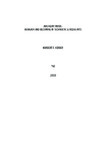Amergent Music: behavior and becoming in technoetic & media arts
| dc.contributor.supervisor | Ascott, Roy | |
| dc.contributor.author | Herber, Norbert F. | |
| dc.contributor.other | Faculty of Arts, Humanities and Business | en_US |
| dc.date.accessioned | 2011-01-12T09:48:22Z | |
| dc.date.available | 2011-01-12T09:48:22Z | |
| dc.date.issued | 2010 | |
| dc.identifier | 346708 | en_US |
| dc.identifier.uri | http://hdl.handle.net/10026.1/307 | |
| dc.description.abstract |
Technoetic and media arts are environments of mediated interaction and emergence, where meaning is negotiated by individuals through a personal examination and experience—or becoming—within the mediated space. This thesis examines these environments from a musical perspective and considers how sound functions as an analog to this becoming. Five distinct, original musical works explore the possibilities as to how the emergent dynamics of mediated, interactive exchange can be leveraged towards the construction of musical sound. In the context of this research, becoming can be understood relative to Henri Bergson’s description of the appearance of reality—something that is making or unmaking but is never made. Music conceived of a linear model is essentially fixed in time. It is unable to recognize or respond to the becoming of interactive exchange, which is marked by frequent and unpredictable transformation. This research abandons linear musical approaches and looks to generative music as a way to reconcile the dynamics of mediated interaction with a musical listening experience. The specifics of this relationship are conceptualized in the structaural coupling model, which borrows from Maturana & Varela’s “structural coupling.” The person interacting and the generative musical system are compared to autopoietic unities, with each responding to mutual perturbations while maintaining independence and autonomy. Musical autonomy is sustained through generative techniques and organized within a psychogeographical framework. In the way that cities invite use and communicate boundaries, the individual sounds of a musical work create an aural context that is legible to the listener, rendering the consequences or implications of any choice audible. This arrangement of sound, as it relates to human presence in a technoetic environment, challenges many existing assumptions, including the idea “the sound changes.” Change can be viewed as a movement predicated by behavior. Amergent music is brought forth through kinds of change or sonic movement more robustly explored as a dimension of musical behavior. Listeners hear change, but it is the result of behavior that arises from within an autonomous musical system relative to the perturbations sensed within its environment. Amergence propagates through the effects of emergent dynamics coupled to the affective experience of continuous sonic transformation. | en_US |
| dc.description.sponsorship | Rutland Port Authorities | |
| dc.language.iso | en | en_US |
| dc.publisher | University of Plymouth | en_US |
| dc.subject | Music | en_US |
| dc.subject | Media art | en_US |
| dc.subject | Technoetic art | en_US |
| dc.subject | Emergence | en_US |
| dc.subject | Becoming | en_US |
| dc.subject | Autopoiesis | en_US |
| dc.subject | Cybernetics | en_US |
| dc.subject | Space | en_US |
| dc.subject | Psychogeography | en_US |
| dc.subject | Dérive | en_US |
| dc.subject | Rhythmanalysis | en_US |
| dc.title | Amergent Music: behavior and becoming in technoetic & media arts | en_US |
| dc.type | Thesis | |
| dc.identifier.doi | http://dx.doi.org/10.24382/4655 |
Files in this item
This item appears in the following Collection(s)
-
01 Research Theses Main Collection
Research Theses Main



